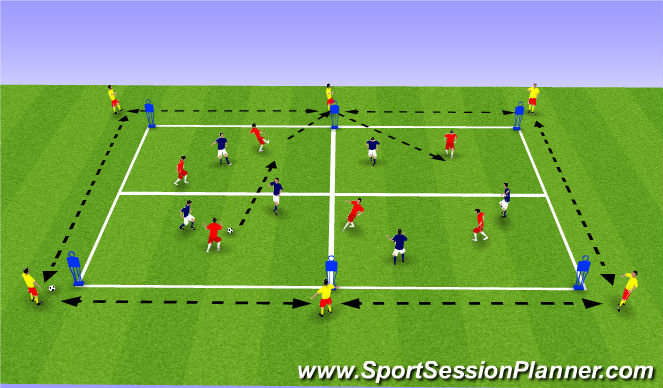

TACTICAL SOCCER SLOTTED BALL RUNS INTO THE BOX FREE
The free play rule produced greater number of duels, lower number of sprints and high-intensity running, and preserved the effectiveness of TT actions compared to 1-2 touches SSG. Number of touches, man marking and presence of goalkeepers affect the physiological, technical and tactical responses of players, so they should be considered to modify the intensity. Therefore, Lacome et al. (2) recommend 4v4 SSGs for strength-oriented training sessions and 10v10 SSGs for endurance-oriented training sessions. The higher number of players, the higher distance per minute. It should be noted that only 10v10 SSGs allow players to obtain similar running distances covered in match (2). However, the areas should be adapted to the level and age of players. 4v4 game situations are played on reduced spaces for areas close to the goals while they are played in open spaces in the central areas. Caro et al. (3) proposed areas of 15x17m or 17x20m. Also, the author found differences in the playing space depending to the area of the field where these actions take place. Caro et al. (3) concluded in its study with elite soccer players belonging to the Spanish First Division that 4v4 SSGs should be played in smaller spaces for a better recreation of match situations, and in addition these should be wider than longer. Contrary, reducing the IPA results in a reduction of playing area and the time available for the task, so the decision-making process and technical execution should be faster.Ĥv4 SSGs are considered the most appropriate game format (1,3). Increasing the IPA might be useful to increase the intensity of SSG (3). IPA is defined as the available game area for each player into the total game area. The interpersonal playing area (IPA) arise from this relationship. The intensity of game is highly affected by the interaction between the pitch area and the number of players and it is considered a critical factor for an appropriate SSG design. Relationship between the pitch area and number of players No intensity changes have been found when teams play with unequal number of players, excepting with the inclusion of floaters players, who attain much higher intensity than other players.Ĭhoosing the appropriate number of players, several authors recommend using a reduced number of players and alternating equal and unequal number of players. The fewer number of players, higher HR, La- and RPE. The work-to-rest ratio was only >1 on medium and large pitches, which indicates that activity prioritizes over recovery (4). On the other hand, work-to-rest ratios are lower in the smallest areas. Larger pitches involve covering a greater HI distance, speed-running and sprint frequency whereas smaller pitches involve a greater number of accelerations, decelerations or changes of direction (4), in addition to a greater number of TT actions. The greater the space, the greater intensity. In addition, lower number of assists, steals and turnover are found in big game pitches. On the other hand, there are also differences in number of shots to goal, rebounds and passes between smaller and bigger game-area.



Thus, larger SSGs is used in training to maintain high-intensity (HI) throughout exercise. This is caused to the greater area per player, with player having more space to move. Increasing the playing area dimensions means an increase of HR, lactate concentration (La-) and RPE. Therefore, SSG seem an effective task to combine the behaviors and motor patterns, the cohesion of the team in addition to aerobic training (1). SSGs allow to train with the ball and achieve an exercise intensity of 95% of maximum heart rate (HRmax), which has been shown to improve the soccer-specific endurance, develop the specific muscle-groups involved in game, improve the TT elements in the specific conditions of game, and keep an effective transfer to the game (1–6). In addition, the S&C Coach must hold good knowledge of TT elements. A good teamwork and communication between the technical staff are essential. However, it should be noted that practitioners need a good knowledge of SSGs in order to properly carry out these tasks adapted to coach’s objectives (2). Small-Sided Games (SSGs) is one of the most common training methods in soccer at all level or ages from elite teams to children, as it allows to develop the technic and tactics (TT) such as situations of numerical superiority, defensive retreat or third man play, among others, keeping the physical objectives programmed in that training session (1).


 0 kommentar(er)
0 kommentar(er)
